Florenz – Cappella Tornabuoni, Ghirlandaio. Einen noch größeren Auftrag als in Santa Trinita führt Domenico Ghirlandaio (1449-1494) mit seinen Brüdern sowie Gehilfen in der Dominikanerkirche Santa Maria Novella aus. Giovanni Tornabuoni (1428-1497) lässt in dem 100 m langen Kirchenbau 1486-1490 die riesige Hauptchorkapelle ausmalen. Der steinreiche Auftraggeber ist als Bankier der Medici auch eine politische Schlüsselgestalt in der Stadt. Sonstige wichtige Bürger der Zeit sind auch hier bei den biblischen Geschehen anwesend.
Domenico Ghirlandaio (1449-1494) with his brothers and assistants carried out an even larger commission than in Santa Trinita in the Dominican church of Santa Maria Novella. Giovanni Tornabuoni (1428-1497) had the huge main choir chapel in the 100 m long church painted in 1486-1490. As a Medici banker, the wealthy patron was also a key political figure in the city. Other important citizens of the time are also present here during the biblical events.
Santa Maria Novella, Fassade von Leon Battista Alberti

Die berühmte, von Leon Battista Alberti (1404-1472) stammende Fassade der Kirche setzt Maßstäbe für die Architektur der Renaissance. Die toskanisch weiträumige gotische Architektur des Inneren ist nicht mehr zu ahnen.
The famous façade of the church, designed by Leo Battista Alberti, sets the standard for Renaissance architecture. The spacious Tuscan Gothic architecture of the interior can no longer be guessed.
Florenz – Cappella Tornabuoni: Ghirlandaio, Cappella Tornabuoni heute und früher
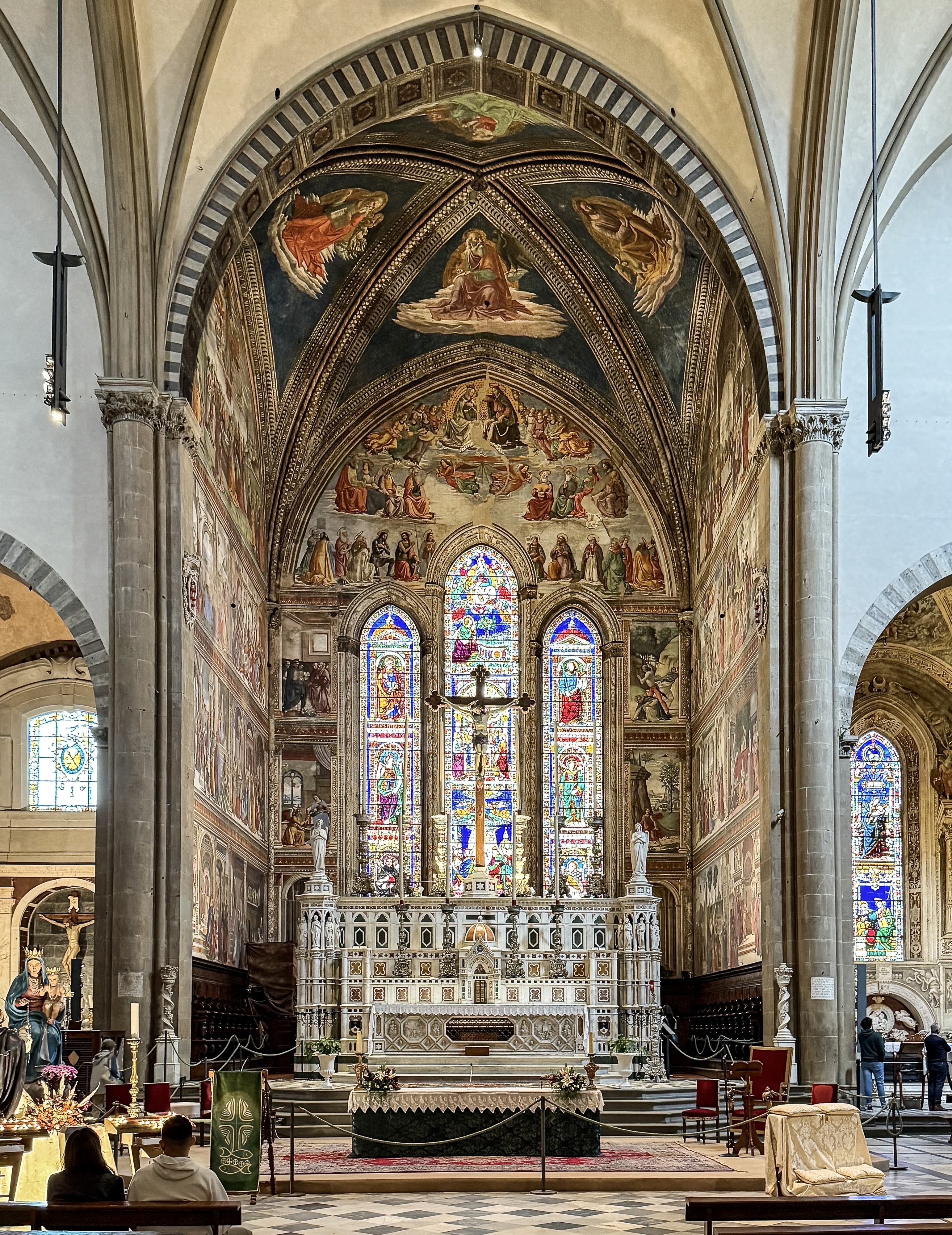
Die Wandmalereien der Hauptchorkapelle der Tornabuoni belaufen sich auf rund 400 qm. Ihre Wirkung ist aus der Ferne etwas eingeschränkt durch den neugotischen Altar des 19. Jh.
In der Kapelle links ist das Kruzifix von Brunelleschi zu erkennen. Rechts befindet sich die Cappella Strozzi mit Fresken von Filippino Lippi.
The murals in the main choir chapel of the Tornabuoni cover an area of around 400 square meters. From a distance, their effect is somewhat limited by the neo-Gothic altar from the 19th century.
Brunelleschi’s crucifix can be seen in the chapel on the left, see above. On the right is the Cappella Strozzi with frescoes by Filippino Lippi.
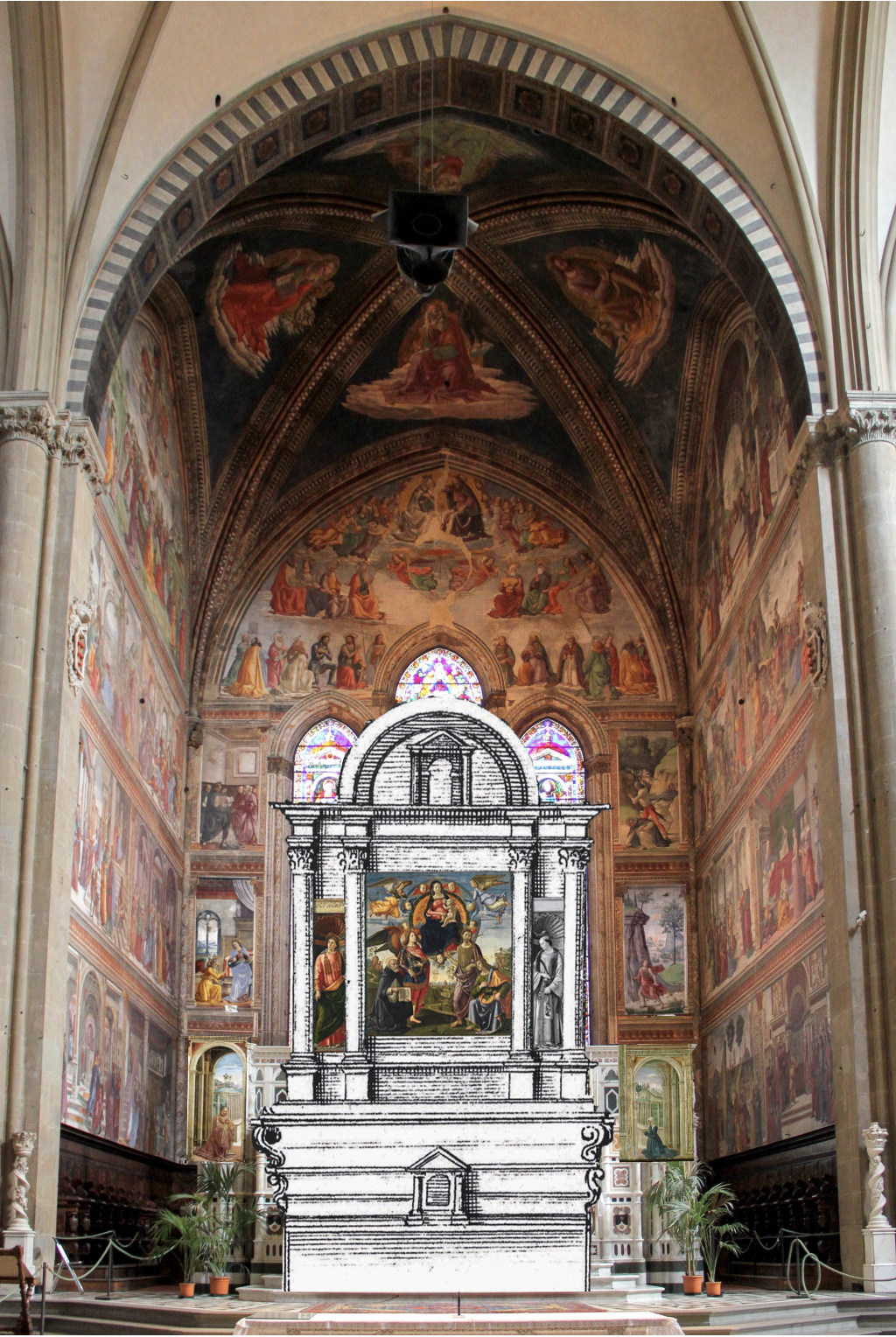
Rekonstruktionsversuch des ursprünglichen Aussehens der Cappella Tornabuoni mit dem gleichfalls von Ghirlandaio und seinen Mitarbeitern ausgeführten Hochaltar, Fotomontage von mir 2018. Die Proportionen des Altars nahmen natürlich Rücksicht auf die Fresken der Stirnwand der Kapelle. So sieht man analog zur Cappella Sassetti im untersten Register (= Bilderreihe) bereits von weitem das Stifterpaar – gewiss ein zentrales Anliegen von Giovanni Tornabuoni.
Reconstruction attempt of the original appearance of the Cappella Tornabuoni with the high altar, also executed by Ghirlandaio and his collaborators, photomontage by me 2018. The proportions of the altar naturally took into account the frescoes on the front wall of the chapel. As with the Cappella Sassetti, the pair of donors can be seen from afar in the lowest register (= row of pictures) – certainly a central concern of Giovanni Tornabuoni.
Szenen aus dem Leben Marias und Johannes des Täufers
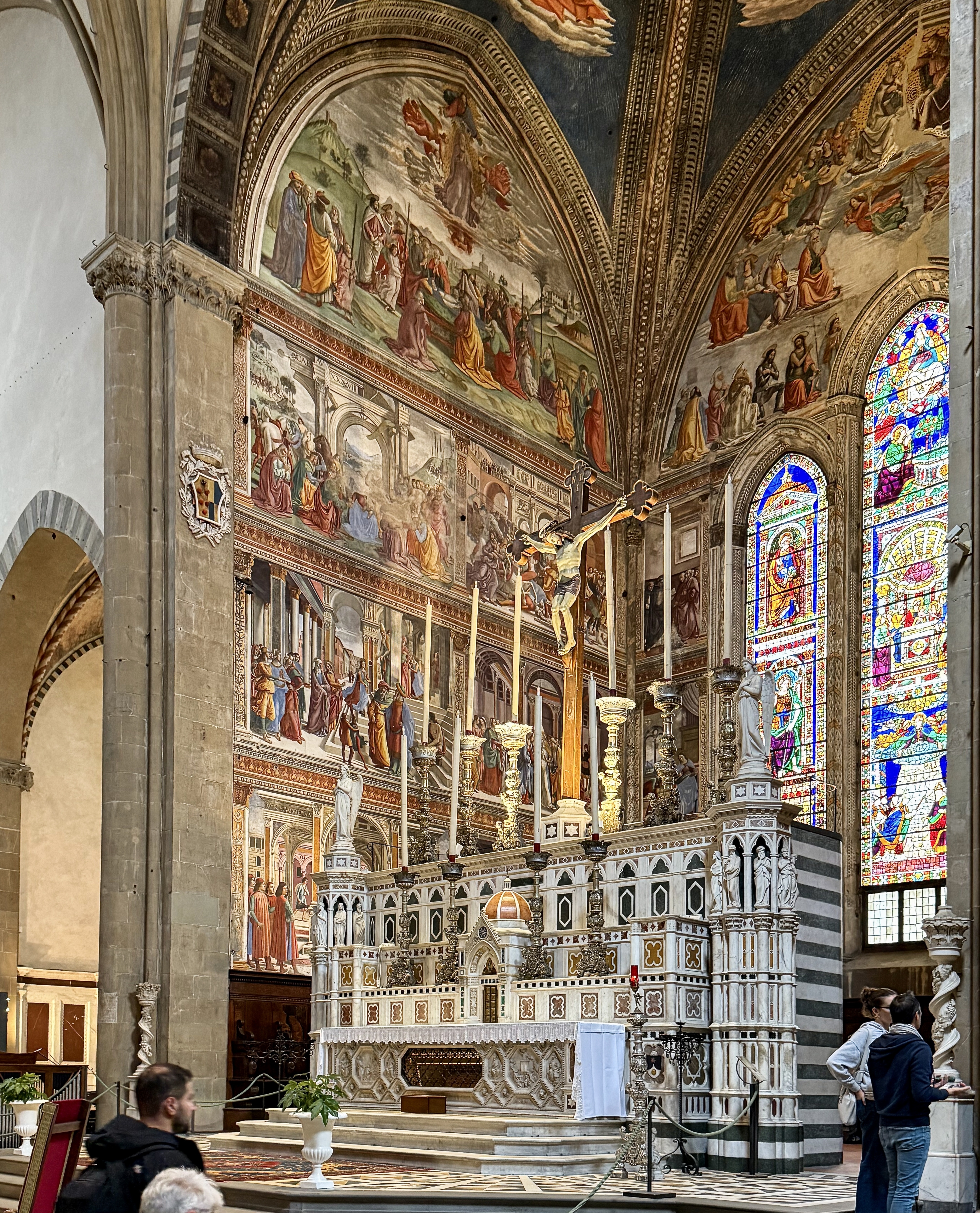
Domenico Ghirlandaio und Werkstatt, 7 Szenen aus dem Leben Marias, von der Vertreibung Joachims aus dem Tempel bis zu ihrer Himmelfahrt. Vertraglich war Ghirlandaio verpflichtet, die unteren Register selbst zu malen. Bei den oberen Bereichen durfte und musste die Werkstatt nach seinem Entwurf entscheidend mitwirken. Ohne Ferngläser war das bei den Lichtverhältnissen der Entstehungszeit kein Problem. Alles trug die Handschrift Domenicos.
Domenico Ghirlandaio and workshop, 7 scenes from the life of Mary, from Joachim’s expulsion from the temple to her Assumption. Ghirlandaio was contractually obliged to paint the lower registers himself. The workshop was allowed and required to play a decisive role in the upper sections according to his design. Without binoculars, this was no problem given the lighting conditions at the time. Everything bore Domenico’s signature.
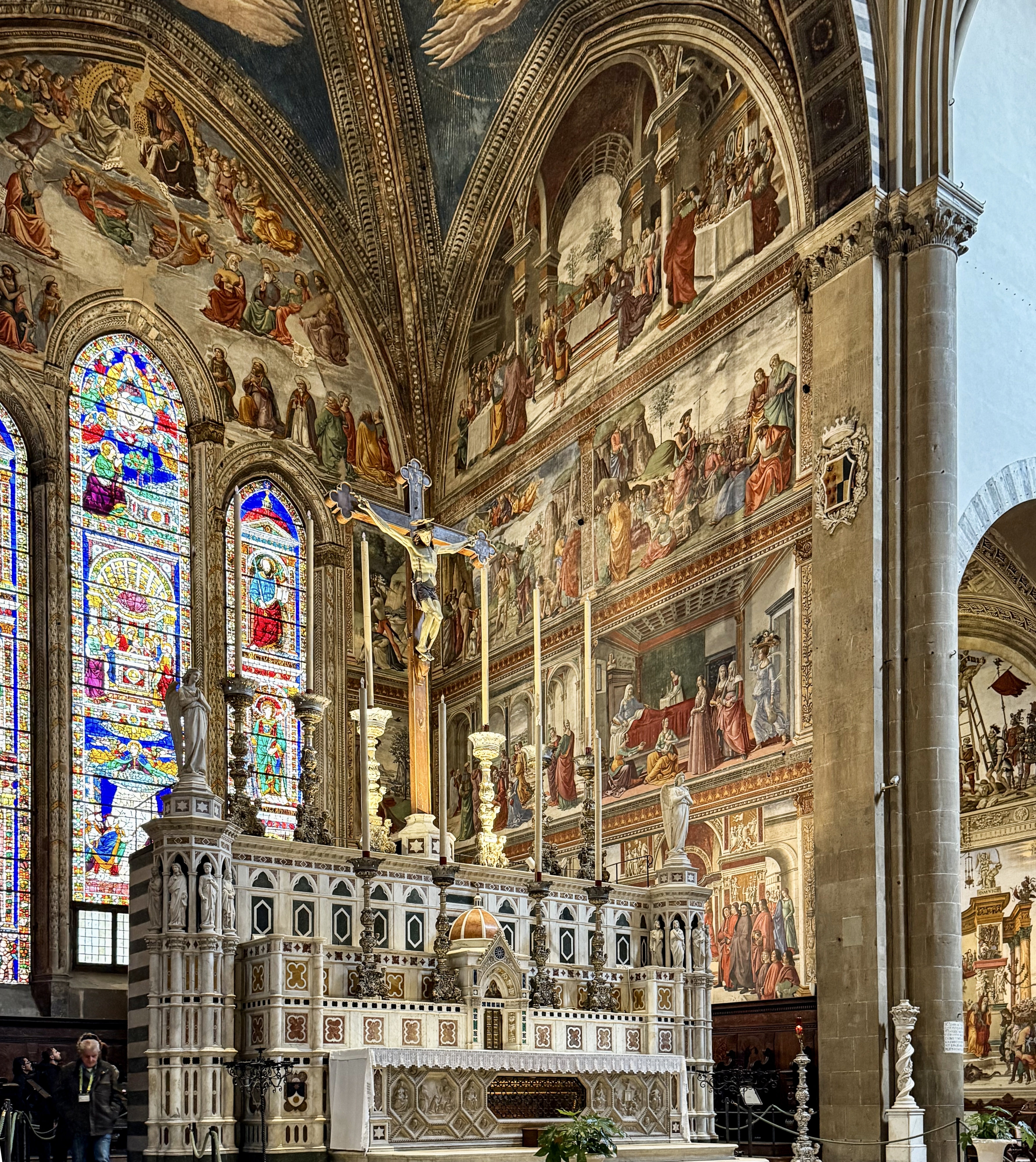
Rechte Seitenwand: Szenen aus dem Leben Johannes des Täufers. Die Stirnwand links lässt als oberen Abschluss die Krönung Marias erkennen.
Right side wall: scenes from the life of John the Baptist. The front wall on the left shows the coronation of Mary at the top.

Stirnwand: Glasfenster nach Entwurf von Domenico Ghirlandaio. In der Mitte unten das Schneewunder bei der Gründung von Santa Maria Maggiore in Rom. In der Mitte die Darbringung im Tempel. Oben Marias Gürtelspende an den ungläubigen Thomas. Linkes Fenster: Dominikus, darüber Johannes d. T. und Petrus. Rechtes Fenster: Thomas von Aquin, Stephanus und Paulus.
Front wall: stained glass window designed by Domenico Ghirlandaio. At the bottom center, the snow miracle at the foundation of San Giovanni in Laterano. In the center, the offering in the temple. Above, Mary’s gift of the girdle to the unbelieving Thomas. Left window: Dominic, above him John the Baptist and Peter. Right window: Thomas Aquinas, Stephen and Paul.
Einzelne Bildfelder

Domenico Ghirlandaio, Erscheinung des Erzengels Gabriel vor Zacharias. Im Tempel mit antikisierenden Reliefs erfährt der Greis von der Geburt eines Sohnes. Gruppen wichtiger Mitbürger Tornabuonis und Ghirlandaios machen die Szene zu einem zeitgenössischen Ereignis.
Domenico Ghirlandaio, Apparition of the Angel to Zacharias. In the temple with antique reliefs, the old man learns of the birth of a son. Groups of important fellow citizens, Tornabuoni and Ghirlandaio, turn the scene into a contemporary event.

Detail des vorigen. Unten links stehen Humanisten, darunter als 2. von links Cristoforo Landino (1425-1498) und als 3. Angelo Poliziano (1454-1494), der auch in der Cappella Sassetti auftaucht.
Detail of the previous one. At the bottom left are humanists, below them Cristoforo Landino 2nd from the left and Angelo Poliziano 3rd from the left.
Florenz – Cappella Tornabuoni: Ghirlandaio – unten malt Domenico, oben die Werkstatt nach seinem Entwurf
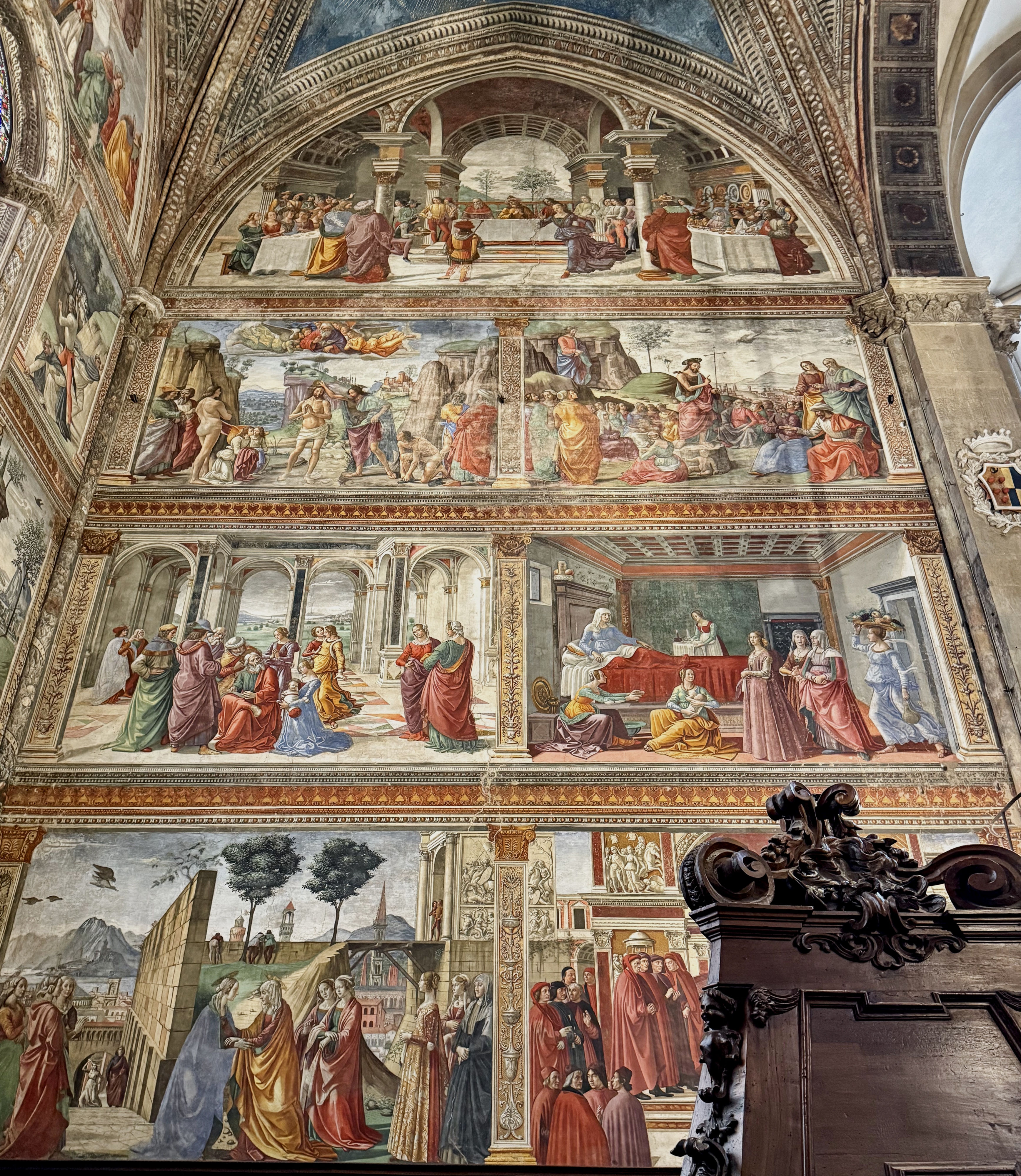
Gesamtansicht der rechten Seitenwand: unten rechts, weitgehend verdeckt, die gerade gezeigte Szene mit Zacharias. Links davon die Begegnung von Maria und Elisabeth. Darüber rechts die Geburt Johannes des Täufers und links die Namensgebung durch den Vater. Darüber die Predigt des Johannes und die Taufe Christi. Im Bogenfeld das Gastmahl des Herodes mit der tanzenden Salome. Im Hintergrund jugendliche Werkstattmitarbeiter Ghirlandaios als Zuschauer.
General view of the right-hand side wall: at the bottom right, largely concealed, the scene just shown with Zechariah. To the left is the meeting of Mary and Elizabeth. Above it on the right is the birth of John the Baptist and on the left the naming by the father. Above, John’s sermon and the baptism of Christ. In the arched field, Herod’s banquet with the dancing Salome. In the background, young workshop workers Ghirlandaios as spectators.
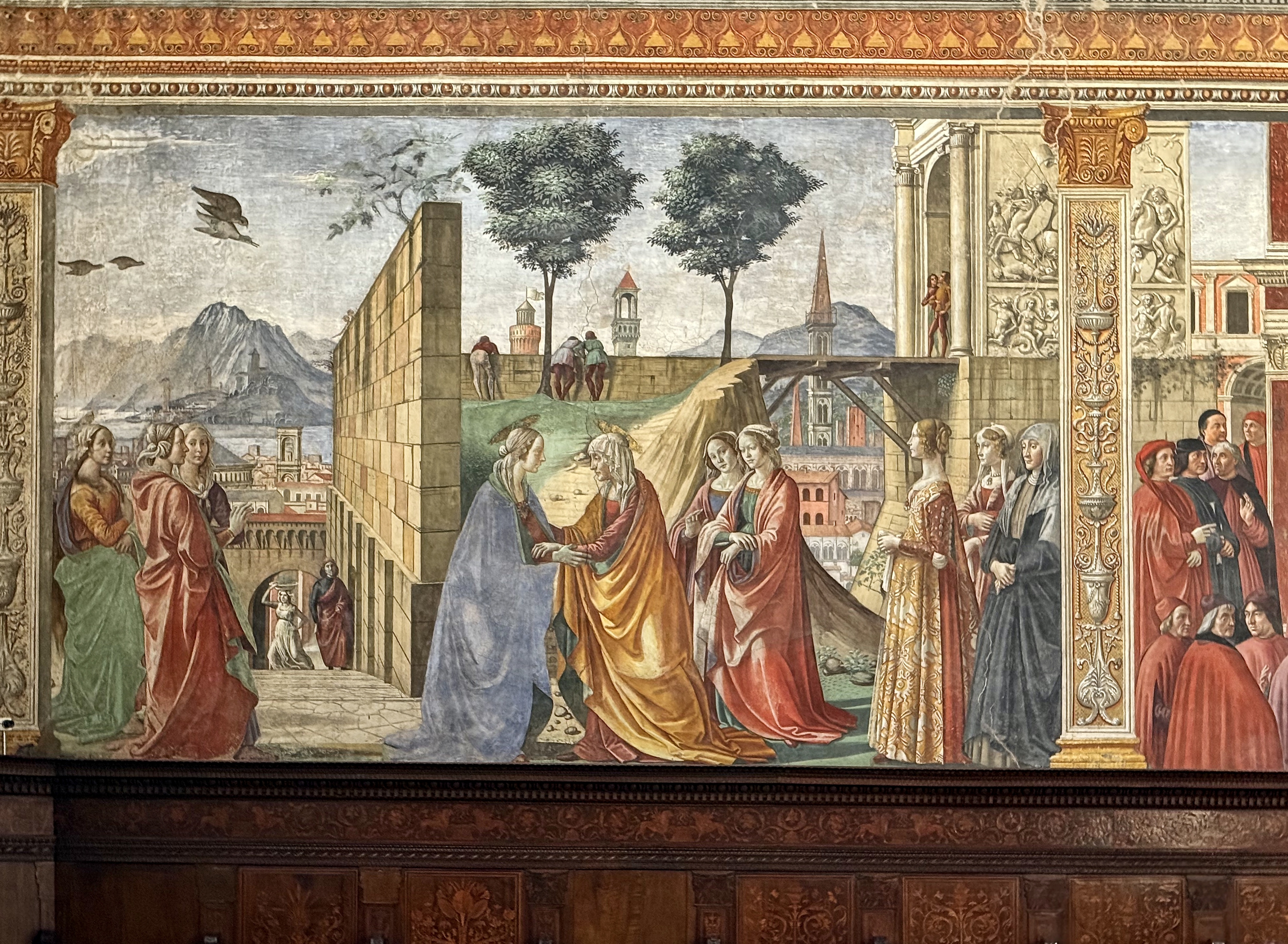
Domenico Ghirlandaio, Begegnung der schwangeren Maria mit Elisabeth in Gegenwart florentinischer Frauen. Rechts im Profil die schöne Giovanna Tornabuoni, geb. degli Albizzi, Ehefrau von Giovanni Tornabuonis Sohn Lorenzo.
Domenico Ghirlandaio, Begegnung der schwangeren Maria mit Elisabeth in Gegenwart florentinischer Frauen. Rechts im Profil die schöne Giovanna degli Albizzi (1468-1488), Ehefrau von Tornabuonis Sohn Lorenzo.
Ein florentinischer Palast als Geburtsort

Domenico Ghirlandaio, Geburt Johannes des Täufers in einem eleganten Florentiner Palastraum. Elisabeth lagert hoheitsvoll, eine Magd bringt Wasser und Wein. Davor zwei Ammen mit dem Neugeborenen. Von rechts kommen drei Besucherinnen, wohl Verwandte von Giovanni Tornabuoni. Gefolgt von einer schwungvollen jungen Frau, die an Botticelli erinnert, mit einem Desco da parto auf dem Kopf.
Birth of John the Baptist in an elegant Florentine palace room. Elizabeth reclines majestically, a maid brings water and wine.In front of her are two wet nurses with the newborn. From the right come three female visitors, probably relatives of Giovanni Tornabuoni. Followed by a lively young woman, reminiscent of Botticelli, with a desco da parto on her head.

Domenico Ghirlandaio, Namensgebung Johannes des Täufers durch den verstummten Vater Zacharias. Die Szene spielt in einer offenen Renaissancehalle, die sich zu einer fernen Landschaft öffnet.
Naming of John the Baptist by his silenced father Zacharias. The scene is set in an open Renaissance hall that opens onto a distant landscape.
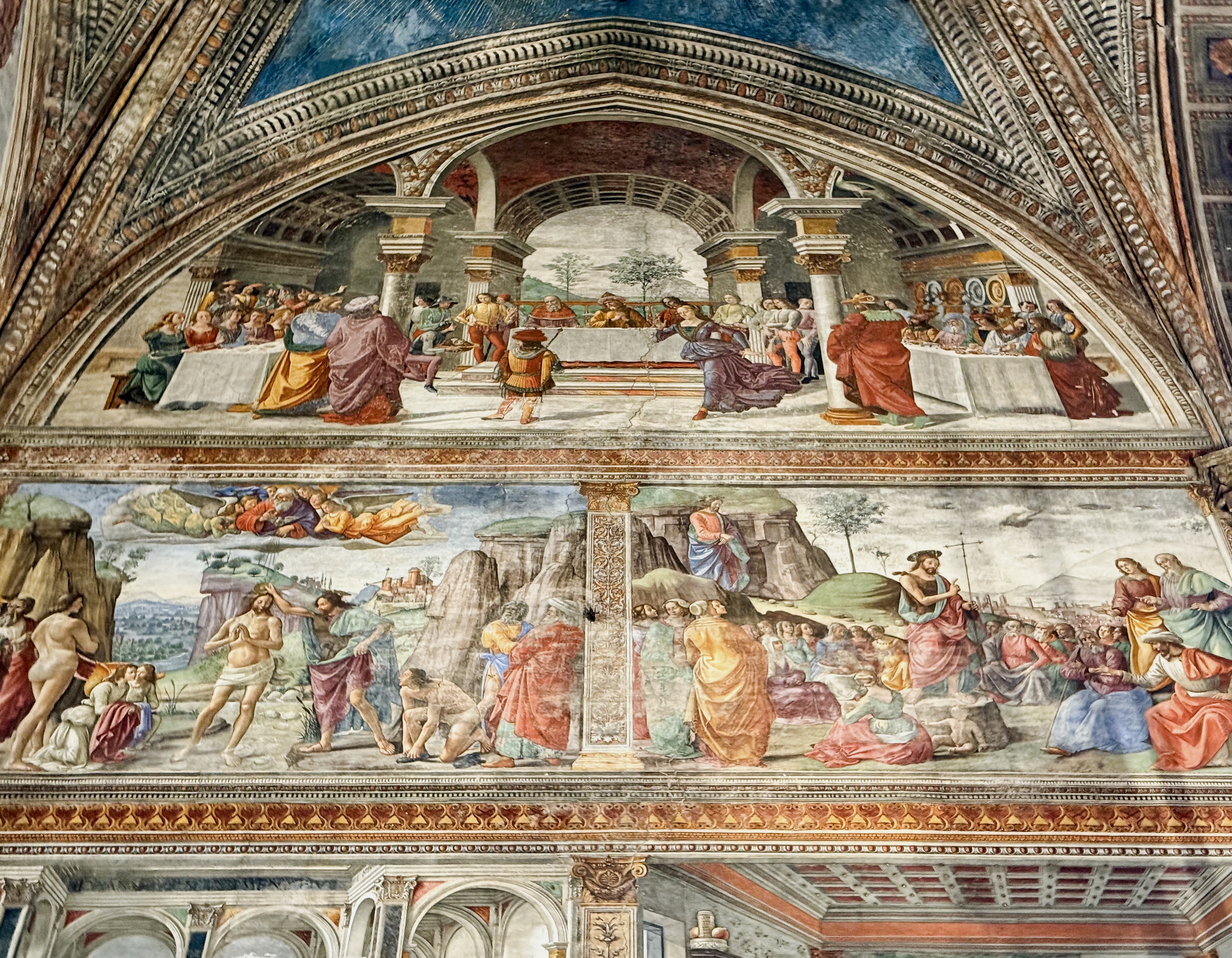
Domenico Ghirlandaio und Werkstatt, die oberen Register der Wand mit Johannes-Szenen: die Predigt des Johannes, Taufe Christi und darüber der Tanz der Salome, der die Enthauptung des Johannes zur Folge hat.
Domenico Ghirlandaio and workshop, the upper registers of the wall with scenes of St. John: the Preaching of St. John, the Baptism of Christ and above it the Dance of Salome, which results in the beheading of St. John.
Florenz – Cappella Tornabuoni: Ghirlandaio, Vertreibung Joachims aus dem Tempel

Linke Seitenwand: Domenico Ghirlandaio, Vertreibung Joachims aus dem Tempel wegen seiner vermeintlichen Unfruchtbarkeit. Ghirlandaio stellt den Tempel als eine schlanke Loggia dar. Wieder sind Zeitgenossen anwesend. Links modisch gekleidet im Stil der 1480er Jahre: Lorenzo Tornabuoni, Sohn des Auftraggebers, und Piero di Lorenzo de‘ Medici. – Rechts ein Detail des benachbarten Freskos: der Kuss von Joachim und Anna, der zu ihrer späten Schwangerschaft und zur Geburt Marias führt.
Left side wall: Domenico Ghirlandaio, Expulsion of Joachim from the temple because of his supposed barrenness. Ghirlandaio depicts the temple as a slender loggia. Again, contemporaries are present. On the left, fashionably dressed in the style of the 1480s: Lorenzo Tornabuoni, son of the patron, and Piero di Lorenzo de‘ Medici. – On the right, a detail of the neighboring fresco: the kiss between Joachim and Anna, which leads to her late pregnancy and the birth of Mary.
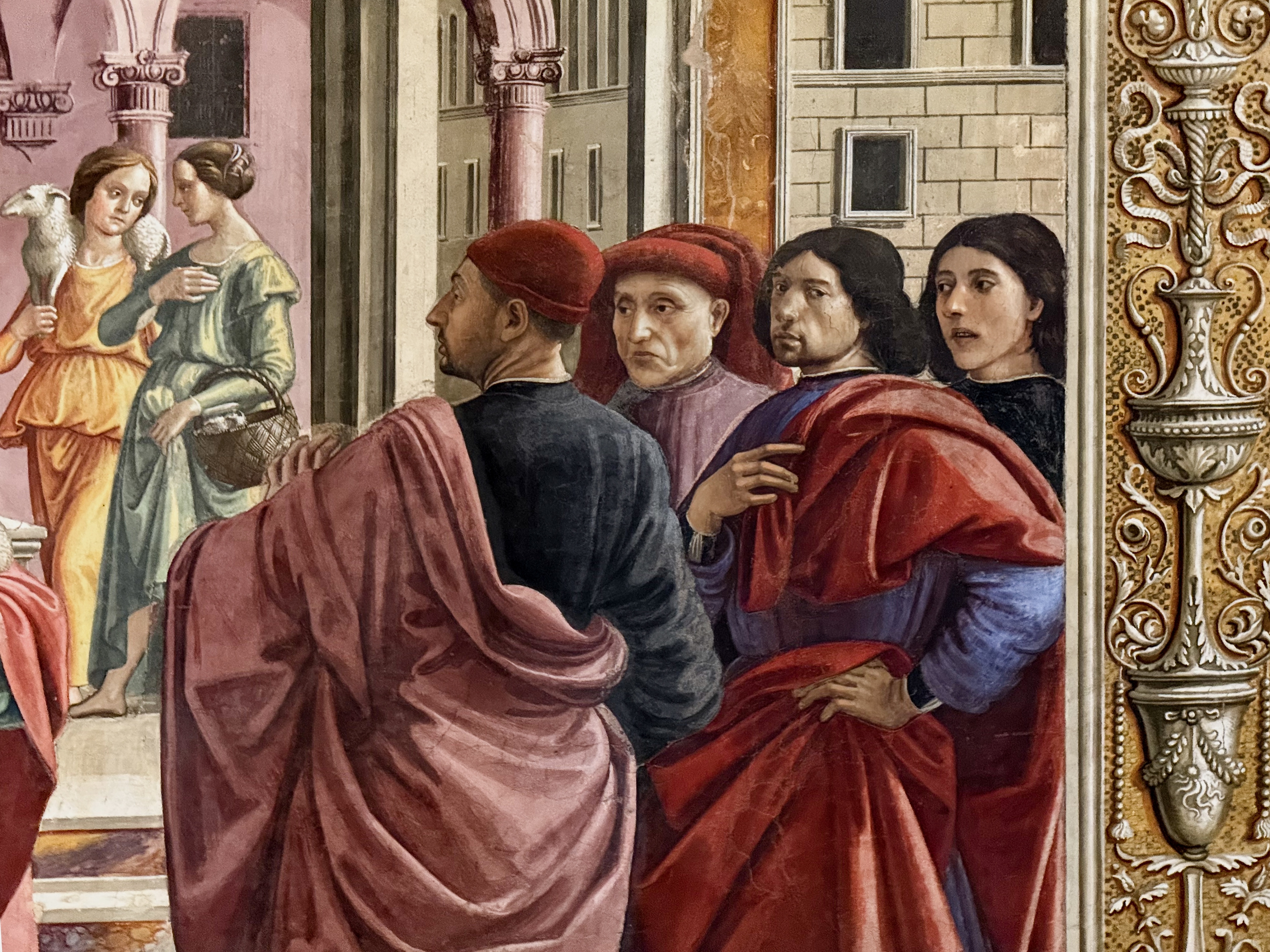
Florenz, Cappella Tornabuoni: Ghirlandaio – Detail des vorigen. Wie schon in der Cappella Sassetti blickt der Künstler in großer Pose selbstbewusst auf den Betrachter.
As in the Cappella Sassetti, Domenico Ghirlandaio looks confidently at the viewer in a large pose.
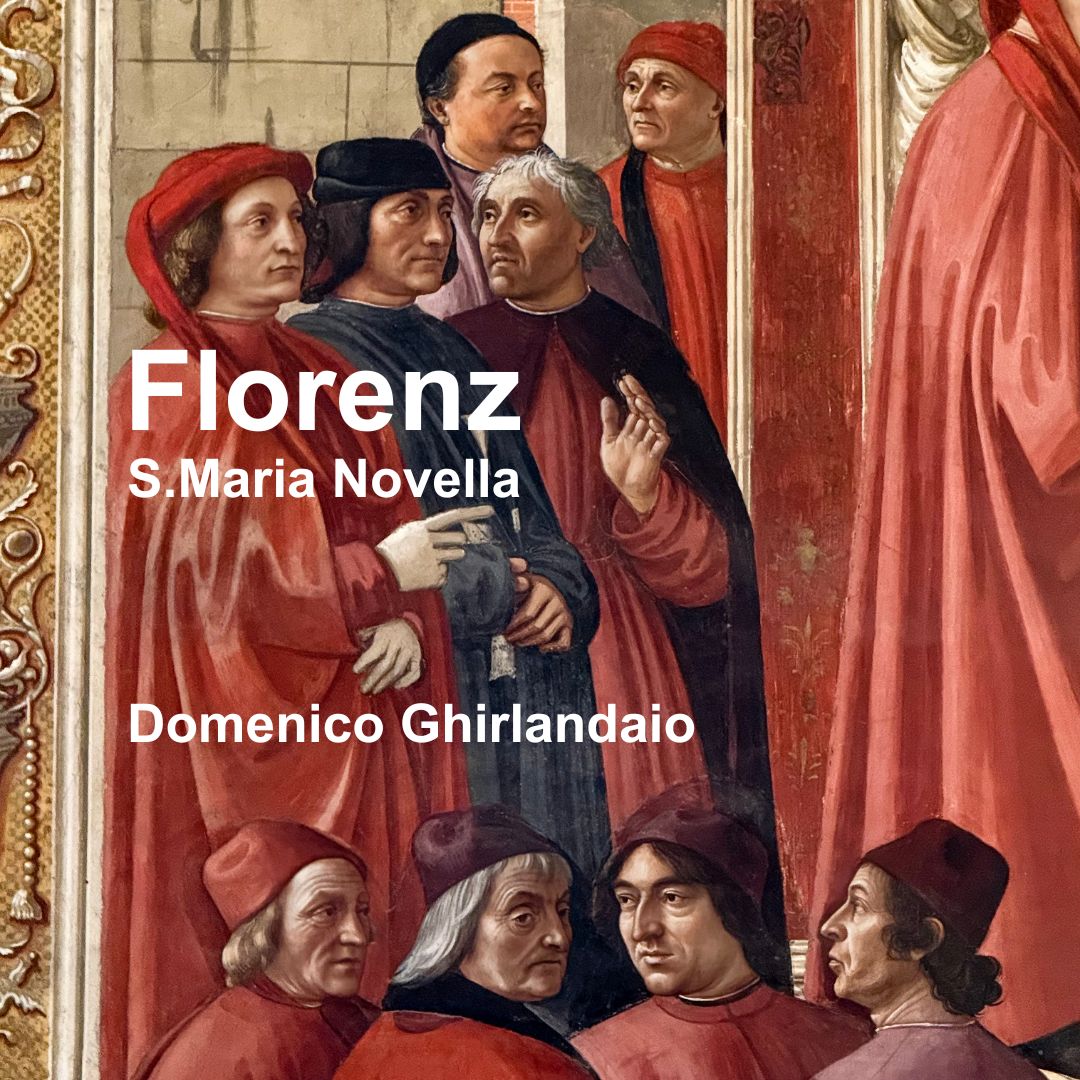
Danke lieber Christian für Deine ungemein gute, genaue und bestens informierte Einführung in die Ikonographie der Kunstwerke in Santa Maria Novella. Ganz großartig und faszinierend!